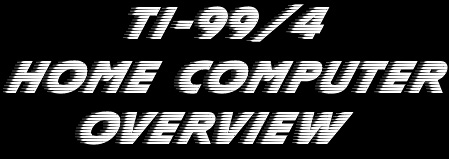| Texas
Instruments Home Computer |
 |


 |
WHAT EXACTLY IS A TI-99/4?  So what exactly is a TI-99/4 Home Computer you ask? Well, the easiest answer to that is that it's the predecessor to the popular TI-99/4A computer. Released in 1979, the 99/4 was TI's first entry into the home computer market and many expected it to make a big splash since it was developed by a major semiconductor company. However, due to many factors (mainly the FCC rejecting TI's RF Modulator and the failure of the cheaper TMS 9985 chip, which both led to a higher than expected price) the computer was a flop when it first hit the market. It was eventually replaced by the improved TI-99/4A console in 1981 which ended up selling somewhere around 3 million units, and can be found on eBay and thrift stores all across the U.S. Now what about the one that started it all, the TI-99/4? Well, most people who have a 99/4A do not even know it exists because it sold at most 100,000 units. This might account for why seeing one in the wild is pretty uncommon and is also the reason why it is highly sought after by collectors. The TI-99/4 sports a chiclet keyboard with orange Shift and Enter keys, and plastic overlays were sold with some of the cartridges which could be placed on the keyboard to show what functions the keys provided. A few of the cartridges would use keys for specialized functions, which made it necessary to package overlays with some of the titles. The computer itself uses the same processor as the TI-99/4A, the TMS 9900, but does have a different video chip in the TMS 9918 (the TI-99/4A uses the updated TMS 9918A, hence the "A" in its name). The 9918 did not have bitmap graphics capability, so all the graphics on the original 99/4 were character based. This in turn lead to some later TI-99/4A cartridges being incompatible (or at least not totally playable) on the 99/4. Titles that come to mind are Parsec and Alpiner which make use of the bitmapped graphics and either don't play at all or don't display everything on the screen. Therefore, while almost all the cartridges released on the TI-99/4A are compatible with the 99/4, there are those which took full advantage of the improved 9918A graphics chip which the 99/4 could not handle. While you might come across numerous TI-99/4A sites on the Internet, there are only a handful that actually make mention and describe the 99/4 and even less that are completely dedicated to it. I only know of this site and Andrew Gurudata's page (which was the original 99/4 site on the web in 1998). Hopefully this site will become a one stop resource for all 99/4 related information, as there are many tidbits of info here that can either not be found elsewhere or require a lot of digging to turn up. So enjoy your stay and get to know the predecessor to the TI-99/4A! A SHORT TI-99/4 HISTORY  The TI-99/4 was announced to the public at the June 1979 CES show and started shipping in October 1979 (Enumerate "Flop", Fortune June 16, 1980 page 139). The computer retailed for $1150 which included a 13" 99/4 Monitor (which was really a re-branded Zenith TV without a tuner). The reason the 99/4 was sold with the monitor comes from the fact that back in February 1979 TI submitted their RF Modulator for FCC approval, however, it was rejected due to the fact that TI only submitted the modulator and not the entire 99/4 system. To work around the FCC rejection, TI was forced to bundle the computer with a color monitor which kept its introduction price quite high. With the TI-99/4 selling for an astronomical $1150 and coming equipped with a chiclet keyboard, the system was a tough sell especially during the early years (TI did eventually get a waiver from the FCC in January 1980 which allowed the 99/4 to be shipped with an RF modulator, bringing the price down to a more reasonable $599). This is probably the main reason why the console and related items are hard to find to this very day. Eventually, TI would unveil the updated TI-99/4A system in June 1981 which would in turn sell 3 million units by the time the last one rolled off the assembly line in 1983. Figures for TI-99/4 sales are more sketchy, but in that same June 1980 Fortune article mentioned in the previous paragraph, an independent market research firm estimated that 25,000 99/4 units would be sold by the end of 1980! Considering the 99/4 ended production in August 1981, that probably means not too much more than 25,000 units were sold. Therefore, TI-99/4 sales figures probably range somewhere between 50,00-100,000, only because the RF modulator option would have helped boost sales somewhat. Even if we go with the high-end estimate of 100,000 units sold you can still see why the 99/4 is hard to find today. For more information check out the Timeline which can be accessed from the main page of this site, as it contains more on the development of the TI-99/4. FUN FACTS  -Earlier builds of the 99/4 console have an earphone jack located on the front left side of the unit. This allowed the user to plug in an ordinary set of earphones to hear the sounds generated by the computer. Apparently this could be of use in noisy environments such as a school. However, starting in late 1980 the jack was removed probably to cut back a little on cost since not many would have had use for it. -European builds of the computer came with a volume control slider below the cartridge port, while U.S. versions of the system had the volume control covered up with a "Solid State Software" badge. It's not known why European units would have/need such a device since the volume could be controlled on the users monitor/TV set. -Some of those above mentioned European models with the volume control also came with a speaker built into the casing underneath the air vent above the cartridge port. It's likely this was the reason for the volume control, to control the built-in speaker of the 99/4 system. However, not all 99/4's with the volume control had a speaker, so the speaker might have been something taken out early on in the European models leaving just the volume control slider switch. -The TI-99/4's cartridge port is a 1/4" closer to the opening of the cartridge slot compared to the TI-99/4A. Only one cartridge is known to have problems with this positioning, and that is Preschool Early Learning Fun which was only released in Europe. -The TI-99/4 was supposed to have an Infrared port built into the top of the console for wireless keyboard and joystick peripherals. However, due to the higher than expected cost of the system they were never marketed and the port was in turn removed. -The computer was initially going to use the cheaper TMS 9985 processor, but due to the chip failing in TI's testing it was never marketed. Therefore, the TI-99/4 had to be shipped with the more expensive TMS 9900. Herbert Taylor who worked at TI owns one of the prototype 99/4's with one of the few TMS 9985 chips ever produced inside of it. -There are 41 keys on the 99/4's keyboard and 48 on the 99/4A. -The TI-99/4 can only type in CAPITAL LETTERS (lower case not supported). -The joysticks sold with the 99/4 are different in size and appearance compared to their 99/4A counterparts. -The TI-99/4's power supply is different from that of the TI-99/4A's. If you try to use a 99/4 power supply on a 99/4A it could fry the system. So be careful! (I talk more about this in the 1998 article I wrote, link provided in the Articles section of this page). -According to Milton Bradley employee Tony Cote, MB played a major role in the development of the TI-99/4 system and might have even developed the computer before TI took over the project. -The 99/4 was shipped with both TI Basic and an Equation Calculator built into the console. Option 1 on the selection screen was for TI Basic and Option 2 for the Equation Calculator. On the TI-99/4A there is only TI Basic built into the system, as Option 1. -The ROM in the 99/4 is 5K larger than the 99/4A due to the built-in Equation Calculator. -The 99/4 has 256 bytes more free memory in TI BASIC than the 99/4A. This leads to some programs written on an unexpanded 99/4 not being able to fit into memory on an unexpanded 99/4A. -The TI-99/4 was actually TI's intermediate computer. They planned on introducing both a TI-99/4 and TI-99/3 in 1979, where the 99/3 would be aimed at the lower-end novice user and the 99/4 at the more computer literate. In the end, the 99/3 never came to market. INTERESTING TI-99/4 ARTICLES  Listed below are a number of articles/messages that I compiled which relate to the 99/4. They are pretty interesting, or at least I think so, and well worth a read if you are curious in finding out more on the history of the system. THE 99/4 HOME COMPUTER (by Charles Good) - An interesting and very thorough in-depth look at the TI-99/4 and some of its history. This was written by the famous TI guru Charles Good in February 1991. TI-99/4 INFO FROM HERBERT TAYLOR - Herbert H. Taylor was involved with designing some of the peripherals for the original TI-99/4 in 1979. He posted this message on comp.sys.ti back in 1991 about some interesting then-unknown tidbits on the history of the computer. THE TI-99/4 (by Bryan Roppolo) - Here's an article that I wrote back in 1998 about the TI-99/4! It's a pretty interesting read and has a good amount of info, such as a fun way to tell if your computer is a 99/4 or 99/4A and also differences in the 99/4 and 99/4A power supplies. BUSINESS WEEK 1979 (PDF) - An original article from the June 18, 1979 issue of Business Week. It talks about the newly unveiled TI-99/4 Home Computer and is a fun read since it comes from the time that the system was first introduced. Check out what people back then were saying about the new system! |
 Back to Main
Page
Back to Main
Page |
|
| Comments,
Suggestions, or Questions? e-mail me: Bryan Roppolo |